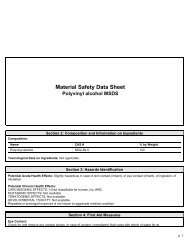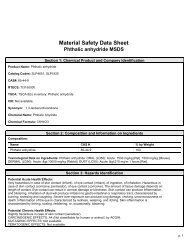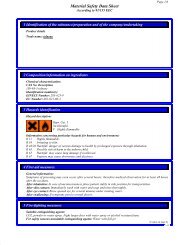metha_acrylic_acid (maa)_msds.pdf - Jpdyechem.com
metha_acrylic_acid (maa)_msds.pdf - Jpdyechem.com
metha_acrylic_acid (maa)_msds.pdf - Jpdyechem.com
You also want an ePaper? Increase the reach of your titles
YUMPU automatically turns print PDFs into web optimized ePapers that Google loves.
Material Safety Data Sheet<br />
Meth<strong>acrylic</strong> Acid MSDS<br />
Section 1: Chemical Product<br />
Product Name: Meth<strong>acrylic</strong> Acid<br />
Catalog Codes: SLM1918<br />
CAS#: 79-41-4<br />
RTECS: OZ2975000<br />
TSCA: TSCA 8(b) inventory: Meth<strong>acrylic</strong> Acid<br />
CI#: Not available.<br />
Synonym:<br />
2-Methylpropenoic Acid<br />
Chemical Name: Meth<strong>acrylic</strong> Acid<br />
Chemical Formula: C4-H6-O2<br />
Composition:<br />
Section 2: Composition and Information on Ingredients<br />
Name CAS # % by Weight<br />
Meth<strong>acrylic</strong> Acid 79-41-4 100<br />
Toxicological Data on Ingredients: Meth<strong>acrylic</strong> Acid: ORAL (LD50): Acute: 1250 mg/kg [Mouse]. 1200 mg/kg [Rabbit]. 1060<br />
mg/kg [Rat]. DERMAL (LD50): Acute: 500 mg/kg [Rabbit].<br />
Section 3: Hazards Identification<br />
Potential Acute Health Effects:<br />
Hazardous in case of skin contact (irritant), of eye contact (irritant), of ingestion, of inhalation (lung irritant).<br />
Corrosive to skin and eyes on contact. Liquid or spray mist may produce tissue damage particularly on mucous<br />
membranes of eyes, mouth and respiratory tract. Skin contact may produce burns. Inhalation of the spray mist<br />
may produce severe irritation of respiratory tract, characterized by coughing, choking, or shortness of breath.<br />
Potential Chronic Health Effects:<br />
CARCINOGENIC EFFECTS: Classified None. by OSHA, None. by NIOSH.<br />
MUTAGENIC EFFECTS: Not available.<br />
TERATOGENIC EFFECTS: Not available.<br />
DEVELOPMENTAL TOXICITY: Not available.<br />
The substance is toxic to lungs, liver, eyes, eye, lens or cornea.<br />
Repeated or prolonged exposure to the substance can produce target organs damage. Repeated or prolonged<br />
contact with spray mist may produce chronic eye irritation and severe skin irritation. Repeated or prolonged<br />
p. 1
exposure to spray mist may produce respiratory tract irritation leading to frequent attacks of bronchial infection.<br />
Section 4: First Aid Measures<br />
Eye Contact: Check for and remove any contact lenses. Do not use an eye ointment. Seek medical attention.<br />
Skin Contact:<br />
If the chemical got onto the clothed portion of the body, remove the contaminated clothes as quickly as possible,<br />
protecting your own hands and body. Place the victim under a deluge shower. If the chemical got on the victim's<br />
exposed skin, such as the hands : Gently and thoroughly wash the contaminated skin with running water and<br />
non-abrasive soap. Be particularly careful to clean folds, crevices, creases and groin. If irritation persists, seek<br />
medical attention. Wash contaminated clothing before reusing.<br />
Serious Skin Contact:<br />
Wash with a disinfectant soap and cover the contaminated skin with an anti-bacterial cream. Seek immediate<br />
medical attention.<br />
Inhalation: Allow the victim to rest in a well ventilated area. Seek immediate medical attention.<br />
Serious Inhalation:<br />
Evacuate the victim to a safe area as soon as possible. Loosen tight clothing such as a collar, tie, belt or<br />
waistband. If breathing is difficult, administer oxygen. If the victim is not breathing, perform mouth-to-mouth<br />
resuscitation. WARNING: It may be hazardous to the person providing aid to give mouth-to-mouth resuscitation<br />
when the inhaled material is toxic, infectious or corrosive. Seek immediate medical attention.<br />
Ingestion:<br />
Do not induce vomiting. Examine the lips and mouth to ascertain whether the tissues are damaged, a possible<br />
indication that the toxic material was ingested; the absence of such signs, however, is not conclusive. Loosen<br />
tight clothing such as a collar, tie, belt or waistband. If the victim is not breathing, perform mouth-to-mouth<br />
resuscitation. Seek immediate medical attention.<br />
Serious Ingestion: Not available.<br />
Flammability of the Product: Combustible.<br />
Auto-Ignition Temperature: 365°C (689°F)<br />
Flash Points: CLOSED CUP: 77°C (170.6°F).<br />
Flammable Limits: LOWER: 1.6% UPPER: 8.1%<br />
Section 5: Fire and Explosion Data<br />
Products of Combustion: These products are carbon oxides (CO, CO2).<br />
Fire Hazards in Presence of Various Substances: Highly flammable in presence of heat.<br />
Explosion Hazards in Presence of Various Substances:<br />
Risks of explosion of the product in presence of mechanical impact: Not available.<br />
Risks of explosion of the product in presence of static discharge: Not available.<br />
Fire Fighting Media and Instructions:<br />
SMALL FIRE: Use DRY chemical powder.<br />
LARGE FIRE: Use water spray, fog or foam. Do not use water jet.<br />
Special Remarks on Fire Hazards: Not available.<br />
Special Remarks on Explosion Hazards: Not available.<br />
p. 2
Section 6: Accidental Release Measures<br />
Small Spill: Absorb with an inert material and put the spilled material in an appropriate waste disposal.<br />
Large Spill:<br />
Combustible material. Corrosive liquid.<br />
Keep away from heat. Keep away from sources of ignition. Stop leak if without risk. If the product is in its solid<br />
form: Use a shovel to put the material into a convenient waste disposal container. If the product is in its liquid<br />
form: Absorb with DRY earth, sand or other non-<strong>com</strong>bustible material. Do not get water inside container.<br />
Absorb with an inert material and put the spilled material in an appropriate waste disposal. Do not touch spilled<br />
material. Use water spray curtain to divert vapor drift. Prevent entry into sewers, basements or confined areas;<br />
dike if needed. Eliminate all ignition sources. Call for assistance on disposal. Be careful that the product is not<br />
present at a concentration level above TLV. Check TLV on the MSDS and with local authorities.<br />
Section 7: Handling and Storage<br />
Precautions:<br />
Keep container dry. Keep away from heat. Keep away from sources of ignition. Ground all equipment containing<br />
material. Do not ingest. Do not breathe gas/fumes/ vapour/spray. Never add water to this product Wear<br />
suitable protective clothing In case of insufficient ventilation, wear suitable respiratory equipment If ingested,<br />
seek medical advice immediately and show the container or the label. Avoid contact with skin and eyes Keep<br />
away from in<strong>com</strong>patibles such as oxidizing agents, <strong>acid</strong>s.<br />
Storage:<br />
May corrode metallic surfaces. Store in a metallic or coated fiberboard drum using a strong polyethylene inner<br />
package. Flammable materials should be stored in a separate safety storage cabinet or room. Keep away from<br />
heat. Keep away from sources of ignition. Keep container tightly closed. Keep in a cool, well-ventilated place.<br />
Ground all equipment containing material. Keep container dry. Keep in a cool place.<br />
Section 8: Exposure Controls/Personal Protection<br />
Engineering Controls:<br />
Provide exhaust ventilation or other engineering controls to keep the airborne concentrations of vapors below their<br />
respective threshold limit value. Ensure that eyewash stations and safety showers are proximal to the<br />
work-station location.<br />
Personal Protection:<br />
Splash goggles. Lab coat. Vapor respirator. Be sure to use an approved/certified respirator or equivalent.<br />
Gloves.<br />
Personal Protection in Case of a Large Spill:<br />
Splash goggles. Full suit. Vapor respirator. Boots. Gloves. A self contained breathing apparatus should be<br />
used to avoid inhalation of the product. Suggested protective clothing might not be sufficient; consult a specialist<br />
BEFORE handling this product.<br />
Exposure Limits:<br />
TWA: 20 (ppm) from ACGIH (TLV)<br />
United States: TWA: 20 (ppm) from OSHA (PEL)<br />
TWA: 20 (ppm) from NIOSH SKIN<br />
Israel: TWA: 20 (ppm)<br />
Consult local authorities for acceptable exposure limits.<br />
Section 9: Physical and Chemical Properties<br />
Physical state and appearance: Liquid. (Above room temperature)<br />
Odor: Repulsive. (Strong.)<br />
Taste: Not available.<br />
p. 3
Molecular Weight: 86.09 g/mole<br />
Color: Colorless.<br />
pH (1% soln/water): Not available.<br />
Boiling Point: 163°C (325.4°F)<br />
Melting Point: 16°C (60.8°F)<br />
Critical Temperature: Not available.<br />
Specific Gravity: 1.015 (Water = 1)<br />
Vapor Pressure: 0.975 mm of Hg (@ 20°C)<br />
Vapor Density: 2.97 (Air = 1)<br />
Volatility: Not available.<br />
Odor Threshold: Not available.<br />
Water/Oil Dist. Coeff.: Not available.<br />
Ionicity (in Water): Not available.<br />
Dispersion Properties: See solubility in water, diethyl ether, acetone.<br />
Solubility:<br />
Partially soluble in diethyl ether, acetone.<br />
Very slightly soluble in <strong>metha</strong>nol, n-octanol.<br />
Section 10: Stability and Reactivity Data<br />
Stability: The product is stable.<br />
Instability Temperature: Not available.<br />
Conditions of Instability: Not available.<br />
In<strong>com</strong>patibility with various substances: Reactive with oxidizing agents, <strong>acid</strong>s.<br />
Corrosivity: Corrosive in presence of steel.<br />
Special Remarks on Reactivity: Not available.<br />
Special Remarks on Corrosivity: Not available.<br />
Polymerization: Yes.<br />
Section 11: Toxicological Information<br />
Routes of Entry: Absorbed through skin. Dermal contact. Eye contact. Inhalation. Ingestion.<br />
Toxicity to Animals:<br />
Acute oral toxicity (LD50): 1060 mg/kg [Rat].<br />
Acute dermal toxicity (LD50): 500 mg/kg [Rabbit].<br />
Chronic Effects on Humans:<br />
p. 4
CARCINOGENIC EFFECTS: Classified None. by OSHA, None. by NIOSH.<br />
The substance is toxic to lungs, liver, eyes, eye, lens or cornea.<br />
Other Toxic Effects on Humans: Hazardous in case of skin contact (irritant), of ingestion, of inhalation (lung irritant).<br />
Special Remarks on Toxicity to Animals: Not available.<br />
Special Remarks on Chronic Effects on Humans: Not available.<br />
Special Remarks on other Toxic Effects on Humans: Not available.<br />
Ecotoxicity: Not available.<br />
BOD5 and COD: Not available.<br />
Section 12: Ecological Information<br />
Products of Biodegradation:<br />
Possibly hazardous short term degradation products are not likely. However, long term degradation products may<br />
arise.<br />
Toxicity of the Products of Biodegradation: The products of degradation are less toxic than the product itself.<br />
Special Remarks on the Products of Biodegradation: Not available.<br />
Waste Disposal:<br />
Section 13: Disposal Considerations<br />
Section 14: Transport Information<br />
DOT Classification: CLASS 8: Corrosive liquid.<br />
Identification: : Meth<strong>acrylic</strong> Acid, Inhibited : UN2531 PG: III<br />
Special Provisions for Transport: Not available.<br />
Section 15: Other Regulatory Information<br />
Federal and State Regulations:<br />
California prop. 65: This product contains the following ingredients for which the State of California has found to<br />
cause cancer, birth defects or other reproductive harm, which would require a warning under the statute:<br />
Meth<strong>acrylic</strong> Acid<br />
Rhode Island RTK hazardous substances: Meth<strong>acrylic</strong> Acid<br />
Pennsylvania RTK: Meth<strong>acrylic</strong> Acid<br />
Florida: Meth<strong>acrylic</strong> Acid<br />
Minnesota: Meth<strong>acrylic</strong> Acid<br />
New Jersey: Meth<strong>acrylic</strong> Acid<br />
TSCA 8(b) inventory: Meth<strong>acrylic</strong> Acid<br />
TSCA 8(d) H and S data reporting: Meth<strong>acrylic</strong> Acid: March 11, 1994<br />
Other Regulations:<br />
OSHA: Hazardous by definition of Hazard Communication Standard (29 CFR 1910.1200).<br />
EINECS: This product is on the European Inventory of Existing Commercial Chemical Substances.<br />
Other Classifications:<br />
WHMIS (Canada):<br />
p. 5
CLASS B-3: Combustible liquid with a flash point between 37.8°C (100°F) and 93.3°C<br />
(200°F).<br />
CLASS D-1B: Material causing immediate and serious toxic effects (TOXIC).<br />
CLASS D-2A: Material causing other toxic effects (VERY TOXIC).<br />
CLASS E: Corrosive liquid.<br />
DSCL (EEC): R34- Causes burns.<br />
HMIS (U.S.A.):<br />
Health Hazard: 3<br />
Fire Hazard: 2<br />
Reactivity: 1<br />
Personal Protection: h<br />
National Fire Protection Association (U.S.A.):<br />
Health: 3<br />
Flammability: 2<br />
Reactivity: 2<br />
Specific hazard:<br />
Protective Equipment:<br />
Gloves.<br />
Lab coat.<br />
Vapor respirator. Be sure to use an<br />
approved/certified respirator or<br />
equivalent. Wear appropriate respirator<br />
when ventilation is inadequate.<br />
Splash goggles.<br />
References: Not available.<br />
Other Special Considerations: Not available.<br />
Section 16: Other Information<br />
The information above is believed to be accurate and represents the best information currently available to us. However, we<br />
make no warranty of merchantability or any other warranty, express or implied, with respect to such information, and we<br />
assume no liability resulting from its use. Users should make their own investigations to determine the suitability of the<br />
information for their particular purposes. In no event shall ScienceLab.<strong>com</strong> be liable for any claims, losses, or damages of any<br />
third party or for lost profits or any special, indirect, incidental, consequential or exemplary damages, howsoever arising, even<br />
if ScienceLab.<strong>com</strong> has been advised of the possibility of such damages.<br />
p. 6














